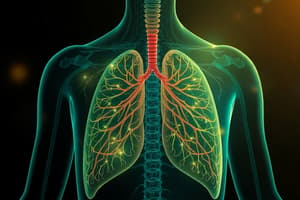Podcast
Questions and Answers
What is the function of the Skeletal System?
What is the function of the Skeletal System?
- Filtering waste products from blood
- Providing structural support and protection (correct)
- Transporting oxygen in the body
- Producing hormones for growth
Which part of the body does the Skull protect?
Which part of the body does the Skull protect?
- Brain (correct)
- Heart
- Liver
- Kidneys
What is the main function of the Muscular System?
What is the main function of the Muscular System?
- Aiding digestion of food
- Regulating body temperature
- Producing new blood cells
- Generating heat during contraction (correct)
Which system controls cognition and communication between cells?
Which system controls cognition and communication between cells?
What do motor neurons transmit signals to?
What do motor neurons transmit signals to?
How many bones are interlinked by joints and muscles in the human body?
How many bones are interlinked by joints and muscles in the human body?
What is the function of the cardiovascular system?
What is the function of the cardiovascular system?
Which system enables gas exchange between air and the bloodstream?
Which system enables gas exchange between air and the bloodstream?
What is homeostasis?
What is homeostasis?
How does the digestive system function?
How does the digestive system function?
Which system secretes hydrochloric acid and proteases for protein breakdown?
Which system secretes hydrochloric acid and proteases for protein breakdown?
What demonstrates resilience and flexibility in the human body?
What demonstrates resilience and flexibility in the human body?
Flashcards are hidden until you start studying
Study Notes
Understanding Life Sciences: Human Body Overview
Life sciences, often referred to as biology, encompass various disciplines dedicated to understanding living systems and organisms. One fascinating area within life sciences is known as "जीव विज्छाणा," which we commonly refer to as life science, with special emphasis on our own species—human beings. In this exploration of human biology, let's delve into the intricacies of the human body through its major components and essential processes.
A Peek Inside Our Anatomy
The human body consists of several interconnected systems working harmoniously together. Some key highlights include:
-
Skeletal System: Provides structural support, protection, movement, and storage of minerals such as calcium; it houses more than 200 bones interlinked by joints and muscles.
- Example: Skull provides protection for the brain and serves as attachment points for facial muscles.
-
Muscular System: Comprising over 600 skeletal muscles responsible for bodily movements; they also maintain posture and generate heat when contracting.
- Example: Biceps assist in flexion of the elbow joint.
-
Nervous System: Controls cognition, communication between cells, and regulation of vital functions like breathing and circulation via two main parts—the central nervous system and peripheral nervous system.
- Example: Motor neurons transmit signals from spinal cord to muscles causing contractions.
-
Cardiovascular System: Transports blood throughout the body containing oxygen, nutrients, hormones, and waste products.
- Example: Heart pumps oxygenated blood to organs while deoxygenated blood returns to lungs.
-
Respiratory System: Enables gas exchange between air and bloodstream, thereby providing oxygen needed for cellular respiration.
- Example: Lungs inflate and deflate during each breath, allowing oxygen uptake and carbon dioxide release.
-
Digestive System: Breaks down food molecules into smaller units using mechanical and chemical digestion before absorption into bloodstream.
- Example: Stomach secretes hydrochloric acid and proteases necessary for protein breakdown.
These seven primary systems make up the foundation of human physiology and work synergistically to sustain life.
Exploring Homeostasis & Adaptability
Human bodies strive to keep internal conditions stable despite external changes. This balancing act is called homeostasis—a complex process involving feedback mechanisms and regulatory hormonal pathways. For example, skin maintains temperature equilibrium via sweat glands and cutaneous vasodilation. If the body detects fluctuations outside normal parameters, adaptations occur to restore balance, demonstrating resilience and flexibility.
As part of your ongoing pursuit of knowledge regarding जीव विज्छाणा, consider exploring these fundamental aspects of human biology in detail, including molecular biology, genetics, evolutionary biology, and much more! Remember that curiosity drives innovation and discovery, so feel free to embark upon this exciting journey of learning about yourself and other living creatures.
Studying That Suits You
Use AI to generate personalized quizzes and flashcards to suit your learning preferences.




